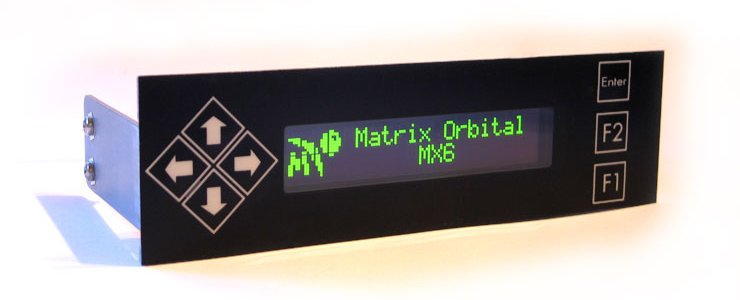
Conclusions
Back when this trend began, your choice was simple: Matrix Orbital or Crystal Fontz. The concept was new, so high prices, small sizes and DIY software was part of the adventure. However, that was four years ago now and in 2005, our expectations are vastly different.Matrix Orbital displays have always been extremely well made but also expensive, and this extends to the MX6. US customers will pay US$109.99 for the display plus accessories. KustomPCs sell them in the UK, but with the extra shipping and VAT, the price blows out to £76. However, the 20 x 2 configuration of the MX6 is somewhat limiting: it occupies a full 5.25" drive bay, yet you can only display 2 lines of text at a time.
We found most of the community-made screens and animations aimed at the larger 20 x 4 models, showing that most customers (quite rightly) prefer the extra real estate of the four-line displays. Matrix Orbital don't offer a four-line PLED display, so by the time you switch to the more expensive VFD technology and supersize an extra 2 lines, you're looking at an MX5 for US$149.99 / £98.99.
At that price, you're looking at three times the price of a PSOne LCD mod, and rapidly approaching the budget required for a 15" LCD monitor mod. Even the cheaper two-line MX6 is twice the price of a PSOne project.
You would hope then that Matrix Orbital's software bundle would rescue the situation, but sadly, it too is stuck in a time bubble. There is no denying that LCDC is very powerful. All credit to the LCDC team: for what is essentially a homebrew application, it offers fine control over every facet of the MX6's feature set. Without it, people would probably be left to code their own software.
However, it is far from polished and while we didn't experience any bugs per se, the hoops the user is required to jump through to output information to the screen leave much to be desired. From a usability point of view, it is arguably software designed by programmers, for programmers - code-shy novice users beware.
Considering that HTPC enthusiasts would be a large part of the MX6's target market, it is positively criminal that it is not Media Center compatible. Again, if one had the determination and skill, one could use LCDC to produce your own custom screens to display various HTPC activities. If you were seriously hardcore, you might even code your own Media Center plug-in for LCDC. However, having forked out big bucks for this display, this functionality should be a mere installation wizard away - it should not be down the community to write their own software.
If the MX6 was £20, you might be more forgiving, considering the additional sensor inputs, fan headers and general potential to make it do whatever you want it to do. At four times that price, functionality should be delivered on a silver platter, not be a box full of Lego. Faced with cheaper alternatives with far greater abilities, it is hard to recommend the MX6 to anyone but the most hardcore fanatic.

MSI MPG Velox 100R Chassis Review
October 14 2021 | 15:04









Want to comment? Please log in.